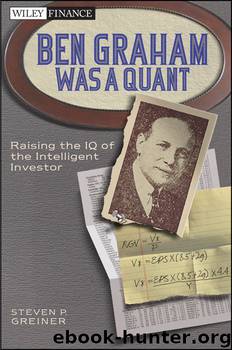Ben Graham Was a Quant by Steven P. Greiner

Author:Steven P. Greiner
Language: eng
Format: epub
ISBN: 9781118013403
Publisher: Wiley
Published: 2011-01-08T05:00:00+00:00
We offset the second earnings stability definition and the second Graham model that uses it for ease of reading the table. The difference in returns between the two models with differing earnings stability definition varies little, though the two definitions of earnings stability used alone clearly demonstrate unique and widely disparate results over the period of the study. Now, the average individual investor is most concerned with absolute returns, which is why the data is shown here in this format. Only institutional investors care about relative returns to a benchmark. However, in both cases, the desirable result is to see a model in which just the first fractile, in this case quintile, outperforms the last fractile.
In this data set, we hope to see that the numbers in column 1 are larger than the numbers in column 5. This is a prerequisite for any factor in any model and, of course, for entire models, too. Why this is so has to do with the economic theory underlying the modeling effort. There is no economic theory that says selecting stocks by any particular financial statement data will contrive a portfolio of stocks that will beat some benchmark. This is because the benchmark is itself a managed portfolio selected using S&P’s, Russell’s, or MSCI’s formulas for index constitution (passive indeed, stated sarcastically!). Hence, we can only compare performance versus a benchmark for some factor, not necessitate a strategy for beating the managed portfolio benchmark. However, we are on good economic ground for specifying that, if a factor explains returns at all, it has to be that sorting by that factor must have the top sort be different from the bottom sort, on average. If we believe the market misprices securities for periods of time and moves away from the nonarbitrage condition, then sorting by valuation where we compare low valuation versus high valuation, it must be the case that the differential is in favor of low valuation. That said however, it must be made clear that there’s no guarantee, nor is their supporting theory that the top quintile would outperform some index.
In Table 6.2, that is the situation for all but the beloved current ratio, the ratio of net current assets to net current liabilities and the first earnings stability measure. Obviously, though a necessary measure by Graham for picking healthy balance sheets, current ratio alone is not necessarily a good picker of stocks, at least not as measured from the empirical data.
Figure 6.1 illustrates a more comprehensive description of the utility of these factors and the two Graham models, created by equally weighting the individual factors. In Figure 6.1, we annualized the returns and then subtracted the annualized return of a hypothetical benchmark consisting of the S&P 500 index. For each factor group (of which there are ten), we show the five quintile excess returns on an annualized basis and what those results are for this study.
FIGURE 6.1 Quintiled Excess Returns of Graham Factor Cohorts
Download
This site does not store any files on its server. We only index and link to content provided by other sites. Please contact the content providers to delete copyright contents if any and email us, we'll remove relevant links or contents immediately.
The Black Swan by Nassim Nicholas Taleb(6762)
Bad Blood by John Carreyrou(6274)
Pioneering Portfolio Management by David F. Swensen(6078)
Millionaire: The Philanderer, Gambler, and Duelist Who Invented Modern Finance by Janet Gleeson(4093)
Skin in the Game by Nassim Nicholas Taleb(3965)
The Money Culture by Michael Lewis(3846)
Bullshit Jobs by David Graeber(3828)
Skin in the Game: Hidden Asymmetries in Daily Life by Nassim Nicholas Taleb(3720)
The Wisdom of Finance by Mihir Desai(3523)
Blockchain Basics by Daniel Drescher(3329)
Liar's Poker by Michael Lewis(3220)
The Intelligent Investor by Benjamin Graham Jason Zweig(2930)
Hands-On Machine Learning for Algorithmic Trading by Stefan Jansen(2925)
Mastering Bitcoin: Programming the Open Blockchain by Andreas M. Antonopoulos(2891)
Fooled by Randomness: The Hidden Role of Chance in Life and in the Markets by Nassim Nicholas Taleb(2860)
Investing For Dummies by Eric Tyson(2793)
The Power of Broke by Daymond John(2771)
Market Wizards by Jack D. Schwager(2538)
Zero Hour by Harry S. Dent Jr. & Andrew Pancholi(2531)
